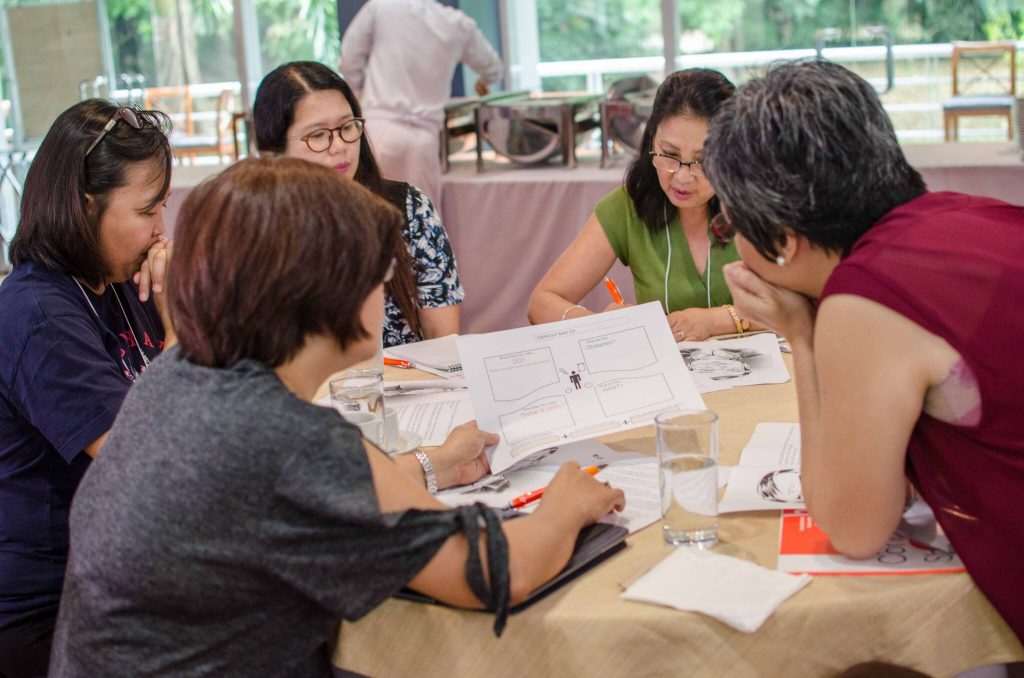Peer Assist

Learning before doing
Overview
Participants are invited to learn with and through peers by sharing experience, insight and knowledge. It is designed to develop context-specific solutions to a particular challenge. It is a participatory and collaborative analysis in order to adapt action to a specific situation.
How to use it
- Connect experienced peers and utilize tacit wisdom.
- Address challenges and facilitate complex analysis.
- Elicit feedback and review projects and processes.
- Engage in collaborative problem-solving.
How to apply it
Start:
- Assess whether the subject matter is explicitenough for the Peer Assist method and whether the participants have experience of the subject matter.
- Identify interesting cases or challenges faced by the participants before the session itself. This can be accomplished in Phase 1 of the Blended Learning Approach or early on in longer courses.
- Providing background information in advance can also be helpful for complex content or lengthy case studies. Instruct all participants to review this before the session itself as a distance assignment in Phase 1.
Setting:
Create groups of 4 to 8 participants.
Materials:
Each discussion group will require a flip-chartsurrounded by a circle of chairs.
Time/Steps:
- Length of time required will vary depending on the complexity of cases selected and the size of the group.
- No less than 1.5 hours is recommended, because time limits can restrict the natural progress of the discussions. The timing indicated below is a guide, and not a strict rule.
- 10 minutes: Introduce the session and divide people into groups.
- 5 minutes: Explain the process and roles (see Participant distribution below).
- 10 minutes: ‘Peer assistee’ presents the selected case study.
- 35 minutes: The groups (peer assisters) discuss options and insights around the problem being explored, based on their own experience.
- 15 minutes: Validate notes and plan a follow-up.
How to adapt it
- A Rotating Peer Assist creates a wider spread of ideas by allowing each group of ‘assisters’ to contribute to more than one case or challenge. The “assistees” move between groups and present their case to each group.
- Enough time must be given to allow each rotation of ‘peer assisters’ to understand the case fully as well as understand the contributions made in previous rounds.
- Every time the ‘peer assistees’ repeat the case, they are likely to understand the problem better and come closer to an actual solution.
- In a Rotating Peer Assist, the facilitator summarizes the observations and suggestions from the previous rounds to avoid repetition. This brief recap at the start of each rotation can stimulate a competitive drive in the participants that is highly productive.
- Approximately 2 to 3 rotations of 25 to 45minutes are ideal. Due to the creative nature of the process, any more than this will simply exhaust the participants.
Case study
Title:
Improving programmes with a peer assist
Activity:
Peer review of training activities
Contact:
J.Lortie@itcilo.org (ILSGEN), T.Wambeke@itcilo.org (DELTA)
Description:
Over several months, units submitted specific courses for in-house review. They had to provide all the information that participants would receive, including the flyer, agenda and session material. The Peer Assist provided activity managers with an opportunity to present challenging programmes to an audience of colleagues who understood the context, and could offer sector or subject-matter insights. It was well received by the participants and 11 different activities received creative and critical feedback. The sharing of ideas and best practice among units contributed to the level of excellence at the Centre itself. This Peer Assist was particularly successful due to the common interests and the high level of motivation among the participants.
Tips
- Have the facilitators of each group record the ideas and insights directly into an accessible format, such as a previously opened wiki, blog, forum, or simple document. The facilitator must be able to type at a reasonable to speed for this to be useful.
- Avoiding the use of flip-charts saves a step and minimizes waste. However, it can create difficulties for visual learners, who may not be able to recall previous points without visual aids. A solution is to provide projectors for each group. Connect them to the computers and ensure each discussion group is near a large, flat, white space.
- Arrange Peer Assist groups by language when the participants have different mother tongues.
Resources
- More information from Learning Resources and Information: “Learning to Fly”, C. Collison and G. Parcell, pp. 97-131.
- Instructional video on Peer Assist at: http://www.youtube.com/watch?v=ObmQyW3EiiE





